New York Giants Week 11: First Look at Detroit Lions Offense
The New York Giants once again found enough ways to win a contested football game coming off their annual bye week.
Despite putting up only seven points in the first half and allowing a season-high 319 passing yards to opposing quarterback Davis Mills, the Giants' fortitude returned in the final 30 minutes when they put up two more touchdowns and forced two turnovers in the red zone to hold down the Houston Texans and win, 24-16. It took some time for the Giants’ to shake off the rust, but with that came their seventh win of the season and their best start to a year since 2008.
As Houston exits the Meadowlands with the loss, the next team to arrive at the Giants' doorstep for the latter half of their homestand is the Detroit Lions (3-6). Sitting at the bottom of the NFC North for the fifth consecutive season, the Dan Campbell-led Lions return to MetLife Stadium for the first time since 2017 and will square off with New York for the sixth time in the last decade.
The last meeting between the two teams occurred in Week 8 of the 2019 season, where things didn’t end in the Giants' favor. Behind a 342-yard, three-touchdown display by former quarterback Matthew Stafford and 123-yard receiving day from current New York receiver Kenny Golladay, Detroit dominated the defense and won a 31-26 outcome to extend their series lead to 24-21-1 and handed the lowly Giants their sixth loss of that season.
Since that matchup at Ford Field three years ago, there have been some noticeable changes to the Lions’ offensive roster. In March 2021, former Pro Bowl quarterback Matthew Stafford was traded to the Los Angeles Rams following eleven seasons at the helm, including eight with over 4,000 total passing yards and nine with at least 20 touchdowns.
Coming with the Rams’ draft compensation was quarterback Jared Goff, whom Detroit immediately threw into the starting role and has accumulated 524 passes for 5,522 yards, 34 touchdowns, and 15 interceptions in 23 starts.
While they largely operated behind a committee of running backs in 2019, the Lions have finally developed a steady, respectable rushing attack with a duo of ball carriers in Jamaal Williams and D’Andre Swift.
The two players combined for 857 yards and 11 touchdowns in the first nine games, and the veteran Williams ranks top-10 among his position in total rushing attempts and touchdowns.
Free agency and the trade market have seen several of Detroit’s top receivers depart for other organizations. Along with Golladay’s signing with the Giants in 2021, the Lions’ lost fellow wideouts Marvin Hall, Marvin Jones, and Danny Amendola to new teams and retirement decisions. Two weeks ago, former tight end stud T.J. Hockenson was traded to the Minnesota Vikings, leaving a gaping hole at the position.
On the other side of their departures, the Lions have unearthed a trio of productive pass catchers in Amon-Ra St. Brown, Josh Reynolds, and Kalif Raymond. All three receivers have at least 20 receptions and 300 yards receiving in 2022, ensuring that they will be involved in the offensive game plan. The Lions are a team that likes to push the field so expect these players to be deployed in a deep attack.
Despite all these changes to their roster, the Lions are a gritty football team and have established a competitive product over the last few weeks. On the heels of beating the Packers and Bears, the team ranks top-10 in total points (219) and yards (3,341). They also average 5.9 yards per play and stand at ninth in the NFL in first downs collected.
The aerial game is the lesser of two evils for an opposing secondary, but they know how to move the football and score in the red zone efficiently. Detroit ranks eighth in both passing yards (2,173) and touchdowns (15), giving them an advantage over the Giants' weaker receiving unit. If there is one problem for the Lions, it’s losing the pigskin, as they have seven interceptions on the season compared to New York’s two.
With Williams and Swift in the backfield, the Lions will look to pound the football if they can’t find opportunities through the air, and they can wear out a defense similar to Saquon Barkley. The duo of backs has rushed close to the top 10 in attempts (245), yards (1,168), and average yards per rush (4.8). They will also get into the endzone, posting the fourth-best touchdown total (11) among league rushing offenses.
Last Sunday, the Giants were able to find enough plays to beat the Texans, as they have several opponents this season. However, it was clear their effort had its serious faults that needed to be fixed heading into Detroit and the oncoming stretch of the schedule.
For a second week, the Lions are no pushover team that will attack the enemy offensively and put points on the board if the Giants are caught sleeping on their record. The good news for New York is the Lions’ defense ranks close to last in the league in many pass and run defense categories, meaning it could be a feast for Big Blue’s offense if they stay clean and crisp on Sunday afternoon.
It could be called a “must-win” affair, but head coach Brian Daboll doesn’t believe heavily in those. Either way, the Giants have another winnable contest in front of them with Detroit, and it will come down to stifling another powerful backfield and forcing the ball into miscues in the air.
Heading into Sunday’s game, let’s take a deeper look at the playmakers on the Lions’ offense and what to watch for when they take the field.
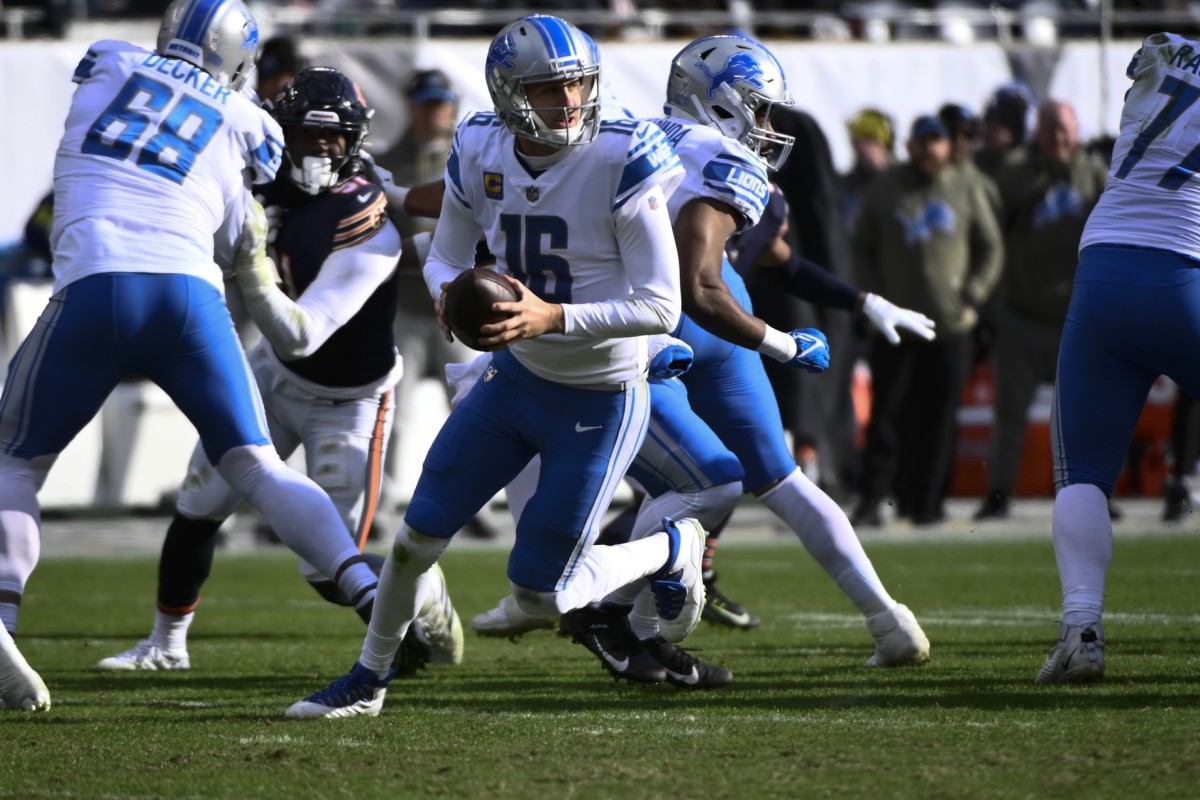
Quarterback
The Giants have been used to seeing Matthew Stafford quarterbacking the Detroit Lions’ offense whenever the two teams have squared off in the regular season. For the first time in a decade, that trend has been bucked by a new face taking over the pocket.
After being drafted by the franchise in 2009 and spending eleven seasons as their Pro Bowl gunslinger, the then 32-year-old Stafford was shipped from the Motor City to Los Angeles in March 2021 in exchange for Rams’ quarterback Jared Goff and draft compensation. Both parties were falling out of favor with their organizations, and the Rams felt Stafford was the upgrade needed to carry the team to a Super Bowl title and made a deal.
While Stafford left for Hollywood and eventually captured his long-awaited title in Super Bowl 56 last season, the results were quite different for Goff. In five seasons leading the Rams’ offense, the former 2016 first-round pick out of California appeared in 69 games and carried the team to four winning seasons and two NFC West titles. The bright lights of the playoffs were a different animal, as none of Goff’s four 3,800+ yard passing campaigns could result in the league’s ultimate crown.
Playing in 14 games during his debut season with the Lions, Goff took his completion percentage to its career-high of 67.2% while tallying 3,245 passing yards, 19 touchdowns (lowest in five years), and eight interceptions (second-lowest single-season total) in the Anthony Lynn system. However, the Lions rode an inconsistent offense marred by injuries and finished with a miserable 3-13-1 record, Goff’s first missed postseason since his rookie year.
Having a new offensive system and coordinator in Ben Johnson this year, things have started to round into shape for Goff and company. The Lions are 3-6 and lightyears more productive on that side of the ball, powered by 192 completions (63.8%) for 2,277 yards and 15 touchdowns from the quarterback’s arm. Goff is on track to smash his totals from the season prior, and his 93.7 average passer rating is his best number since 2018, when he lost in the Super Bowl.
When he was selected No. 1 overall by Los Angeles in 2016, the team’s draft scouts loved Goff for his mix of good size, arm strength, advanced pocket mobility, and on-field demeanor. Standing at 6’4”, 217 pounds, the 28-year-old is a little slim in his lower body but boasts enough dual-threat athleticism with his solid arm to serve as a franchise quarterback long-term.
Provide Goff with a clean pocket to throw the football, and there are very few areas of the open field he won’t reach in the passing game. Upon taking the snap, he displays professional-level footwork and field vision while dancing in the pocket and waiting for his receiver’s routes to develop. At the release, he slings the ball with a clean flick of the wrist and fiery hips, letting the velocity and accuracy do the rest en route to his teammate’s breadbasket.
Goff’s internal clock will be tested by the Giants’ pressure-heavy defensive front and blitz-heavy schemes from the second and third levels. Still, he knows how to balance that with his legs to get out of the pocket and extend plays toward the boundaries. If he recognizes a blitz from the outside, Goff will climb up the pocket with poise, escape to the edge and either run the ball upfield or send an off-balance angle throw to his receiver in both wide and tight windows alike.
Above all, Goff’s best quality is his ability to test the defense with different looks and make them guess where he will send the football next. In the play-action offense, he excels at selling the dump-off plays and short routes over the middle, drawing the inside linebackers out of their coverage zone for a bigger play at the second level. He is fine with playing the chunk yardage game. Still, he will not waste an opportunity to attack the intermediate or deep field, especially on third and long situations when he seeks a first down over the simple check down.
Last week, the Giants' defense benefited from playing a more one-dimensional quarterback in Davis Mills, who lacked the rushing fundamentals to overcome the aggressive stuffers along the front line. Yet, Goff carries a different breed of play to the position than the predecessor and will torch Wink Martindale’s crew if they don't stay mentally sound throughout the game. It’ll be a good test of the team’s preparedness to face the league’s best passers down the stretch, and New York hopes to fare well in that challenge.
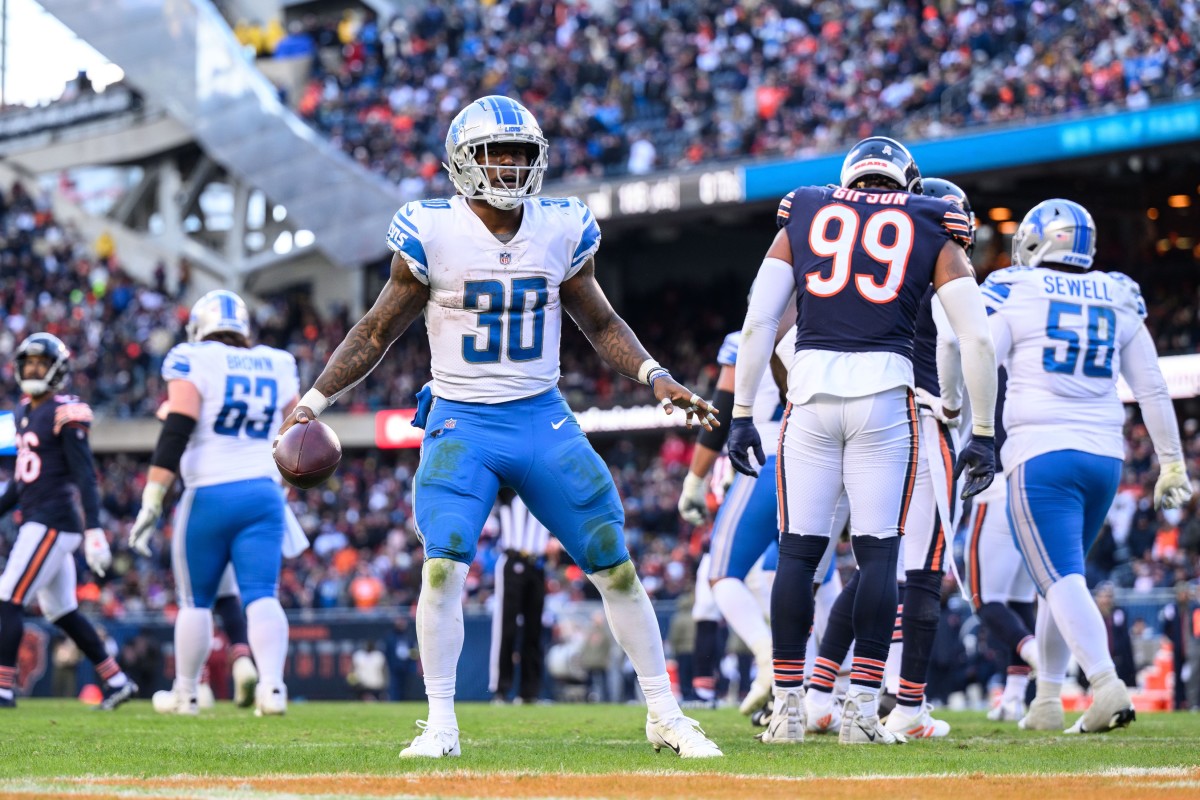
Running Backs
When Dan Campbell took over the reins in Detroit last fall, he was about bringing the smashmouth brand of football back to the Lions’ organization. That included reviving the team’s punishing ground game that characterized the 1990s Barry Sanders era, and so far, it seems to be working, with his running back circle tearing it up in 2022.
One year after having a mediocre rushing game that blanketed the bottom half of the league in attempts (21st), yards (19th), and touchdowns (24th), the Lions’ backfield attack is giving opposing defenses fits with their speed, strength, and versatility in the open field. The two heavy hitters on their roster—Jamaal Williams and D’Andre Swift,
Williams, a sixth-year running back out of BYU, leads the Lions in the rushing department and has become one of the NFL’s elite rushers through ten games. A former fourth-round pick by the rival Packers in 2017, his totals include 142 attempts for 604 yards, nine touchdowns, and an average of 4.3 yards per rush. The former three numbers rank him 16th or better among his peers and have carried him to four starts with at least 79 yards on the ground.
Dating back to his days in college and Green Bay, Williams has been beloved for his NFL size and physical nature carrying the football, two traits that have allowed him to maintain at least a back-end spot on two teams’ depth charts. At six feet tall and 214 pounds, he runs with a decisive, bullish attitude and steady feet and thrives at pounding the play through the interior gaps on inside zone schemes.
Since his prowess comes up the middle, Williams is not a running back whom the Giants’ will see spill the play outside for huge yardage. One reason is that he lacks the speed of someone like Saquon Barkley to beat out edge defenders. Even more than that, he doesn’t like to dance between changing gaps, nor is the elusiveness there to break off tackles and get into the open field.
Instead, the 27-year-old will take the handoff and bash up the first interior gap he sees, pushing behind his front blockers to earn the extra yardage needed to extend the drive. Williams has an excellent bend and contact balance between absorbing a gang of tacklers in the first level and excels at protecting the football at all costs (fumble rate of 1 per every 140 carries in college).
By some miracle, Williams breaks free and has space between himself and the next level, don’t expect to see a highlight play down the open field. With his decent leverage in the upper body, he has an average stiff arm to shed angle tacklers but does not carry the sudden jump cut or spin move to allude to oncoming defenders. He’s also susceptible to pesky arm tackles, a benefit when tackling efforts go awry.
On the other hand, Swift is the Lions’ versatile and talented every-down running back who thrives in both inside and outside zone schemes. A 2020 second-round pick out of Georgia, the 23-year-old has risen Detroit’s depth chart over the past three seasons, collecting 305 rushes for 1,391 yards, 15 touchdowns, and an average of 4.6 yards per attempt over that span.
Through the six games, he’s played this season, Swift has 40 carries for 253 yards and two touchdowns, and his average rush of 6.3 yards is a career-high to this point. The third-year player is not a violent rusher like his counterpart in Williams. Still, his play traits and skillful running style enable him to give the Lions’ offense stability and production in several different scenarios.
At his core, Swift has been dubbed a “cerebral” runner with tempo and decisiveness as his calling cards. He greatly understands different blocking schemes and trusts his offensive linemen to open up creases for him to dart through. He’ll take what the blockers give him in the tight quarters with a rare feel and vision, but if the interior closes, he will use quick-cut agility and spatial awareness to react, reverse directions and attack the second level.
If he breaks to the second level via the edge, Swift will read when the linebackers are overflowing on zone coverage and make late run adjustments back inside to press deeper runs up the middle. Even at 5 '9”, 208 pounds, he isn’t afraid to make direct contact with tacklers, shedding them with fluid twists and turns before accelerating for extra yardage.
Beyond the backfield, Swift is also a player who occasionally finds himself involved in the Lions’ passing attack. In his professional resume, the former Bulldog had his first two seasons end with at least 350 receiving yards and two touchdowns, meaning the production extends beyond the handoff.
He can line up behind the line of scrimmage or out wide in an empty set and run an expanded route tree with solid breaks that cover the front two levels of the field. His hands are soft and sticky at the point of the catch, and they can shift into quality blockers in pass protection.
Swift hasn’t been a home run hitter since entering the league in 2020, but with a long rush of at least 50 yards in each of his three seasons, he’s a weapon that can torch the Giants defense to the endzone if given the right amount of space.
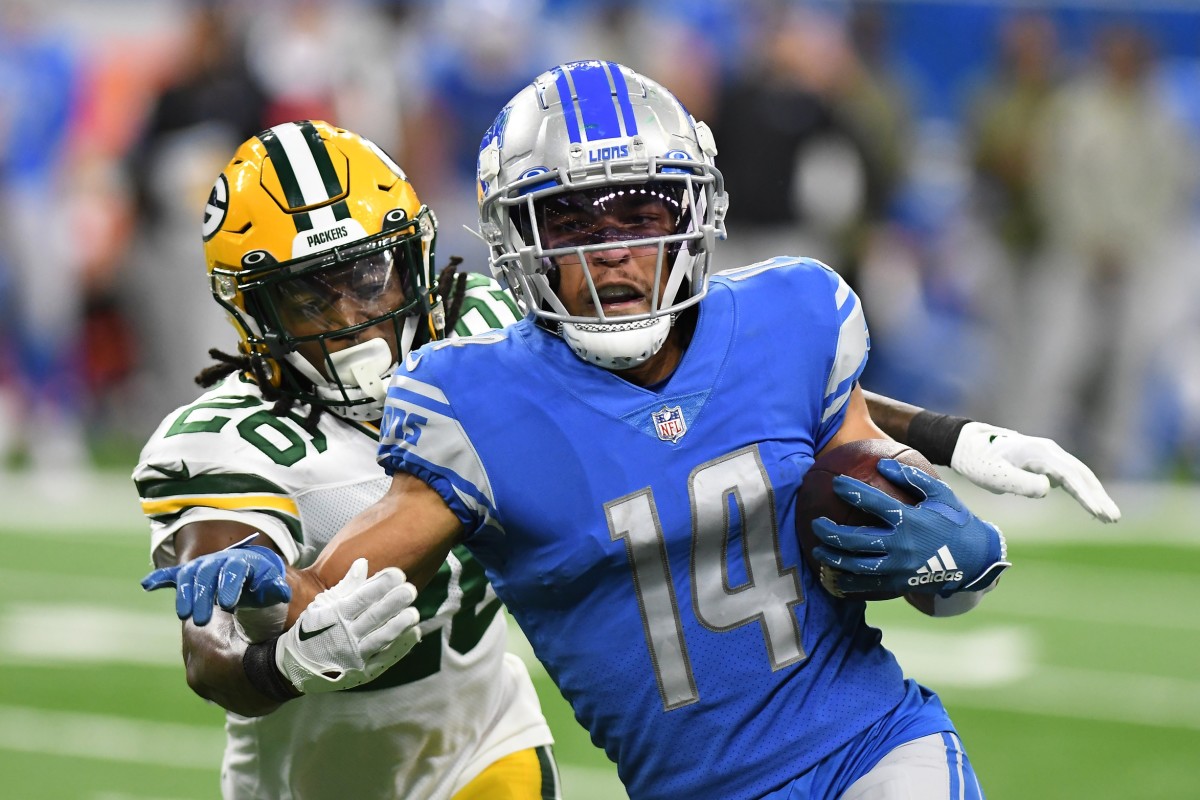
Wide Receivers
Like the Houston Texans last Sunday, the Detroit Lions come packing with a trio of productive wide receivers to challenge the Giants’ secondary in the air. Amon-Ra St. Brown, Josh Reynolds, and Kalif Raymond are their ranking members.
St. Brown, whose brother Equanimeous plays for the Chicago Bears and faced the Giants in Week 4, stands atop the Lion’s receiver leaderboard through the first nine games. A 2021 second-round pick out of USC, he’s appeared in 25 starts over two seasons and has accumulated 49 receptions for 518 yards (10.6-yard average) and three touchdowns this fall.
While he can be rotated in and out of the slot position, the Lions like his athletic profile enough to rely on him from the outside. From there, the 23-year-old St. Brown brings crafty releases, quick feet, and well-polished route running to any level of the field he pursues.
Coming off the snap, St. Brown displays a varying release as he deciphers whether the corner will play press or zone coverage against him. If it’s the former, he takes on contact with firm body control and competitive hands, shifting his acceleration into high gear towards the stem of his route once any separation is achieved.
Breaking off to his route in the open field, St. Brown maintains his top speed and uses his eyes and shifty cuts to adjust and mirror the quarterback wherever the play is extended in play action. With the ball soaring in his direction over the middle or down low, he has a good feel for lingering defenders at his hips and can extend his body laterally to make the distanced catch.
In terms of being a deep threat, St. Brown sometimes struggles with gaining consistent vertical separation against press defenders, leading to failed attempts at hitting the receiver on the fly. Yet to counter that, he utilizes above-average ball-tracking skills and body control to help battle the corner downfield and increase his odds of making a contested catch over the top. With the ball, St. Brown has enough contact balance to shed the initial tackler and earn a few extra yards after the catch.
Reynolds sits second on the Lions depth and production chart, tallying 26 receptions for 352 yards (13.7 average) and two touchdowns in his seven appearances. A former 2017 fourth-round pick by the Los Angeles Rams, the 27-year-old spent four seasons in Hollywood, earning 1,450 and nine touchdowns before leaving for Tennessee in 2021 and then Detroit during the same season.
In 14 games played for Detroit, Reynolds has already ensured his second campaign with at least 19 receptions and 300 yards receiving. Like St. Brown, the Texas A&M product can play both inside the slot and out wide and provides the Lions’ offense with another dangerous vertical threat with his great ball tracking and deep speed.
Whether running against the press coverage or loose zone, Reynolds pops up the line of scrimmage with his flexible hips and works to out-stride the corner into the second and third level. He acts like a center fielder in terms of his ball tracking, with an ability to judge trajectory and distance and shift into a different gear and direction when the ball is in the air. Eye-hand coordination is no weakness of Reynolds either, as he can fight for contested 50/50 balls and rip them down from the crowd of defenders.
The receiver has also been labeled a “menace” in the red zone, where he loves to take advantage of mismatches to get on the scoreboard. At 6’3”, 194 pounds, Reynolds isn’t the strongest specimen on the field, but he can stack cornerbacks on his hip as the ball nears and climb over the ladder to secure the play. He’ll run a lot of back shoulder, and inside slants inside the 20-yard line, both routes, he tends to win with his speed and lanky frame.
Despite his size, Reynolds is an extremely tough football player because of his fearlessness to take on contact and pressure. He will work the middle of the field for looks and does not fear making the catch with incoming linebackers and corners crashing down on him. If he has to lead block as a decoy, he gets after the block with aggression and maintains that down the perimeter.
Raymond, 28, is in his second season with the Lions after the journeyman signed a one-year contract in March 2021. He went undrafted out of Holy Cross in 2016. He spent time with the Denver Broncos, Giants, Jets, and Tennessee Titans, accumulating 19 receptions for 369 yards and one touchdown before laying ground in the Motor City.
That dismal resume has shot through the roof since putting on the Lions’ logo. In 25 games, Raymond has totaled 71 receptions for 878 yards and four touchdowns, doubling his production from the previous four teams combined. This year, he’s third-best among Lions’ receivers with 23 catches for 302 yards and an average catch of 13.1 yards, the third-best average marking of his career.
Detroit’s primary focus in partnering with Raymond has been to put him in the slot position and let him be the big-play threat with his flashy speed and nifty hands. Pure speed puts it lightly, as the receiver boasts an insane 4.34 40-yard dash time that can loosen up opposing defenses. In 2021, Raymond made his living catching the deep balls from Jared Goff, posting a career-high 19.4 yards per catch in 16 games.
When the ball isn’t flying in his direction, Raymond can use his vertical speed to serve as a decoy for his fellow receivers, clearing defenders out for underneath plays to happen in the immediate field. He can also add value in the special teams department, where he’s returned 87 punts for 778 yards and 54 kickoffs for 1,138 yards in his six-year tenure.
On the rare occasion that opposing coverage is locked against him, Raymond has what it takes to create separation and win at the point of the catch. He has a laser-focused concentration in press coverage situations that allows him to keep track of the football and extend his body and arms in different directions to secure the ball from his frame and the defender’s grasp.
His alertness to the environment around him is special as well. Raymond is no stranger to catching a low ball, juking out the oncoming defender, and taking the catch to the house for a touchdown. That similarity will make casual viewers compare him to Slayton after the Giants receiver’s recent score against Houston, and that may be who the Lions will get when Raymond takes the field on Sunday.
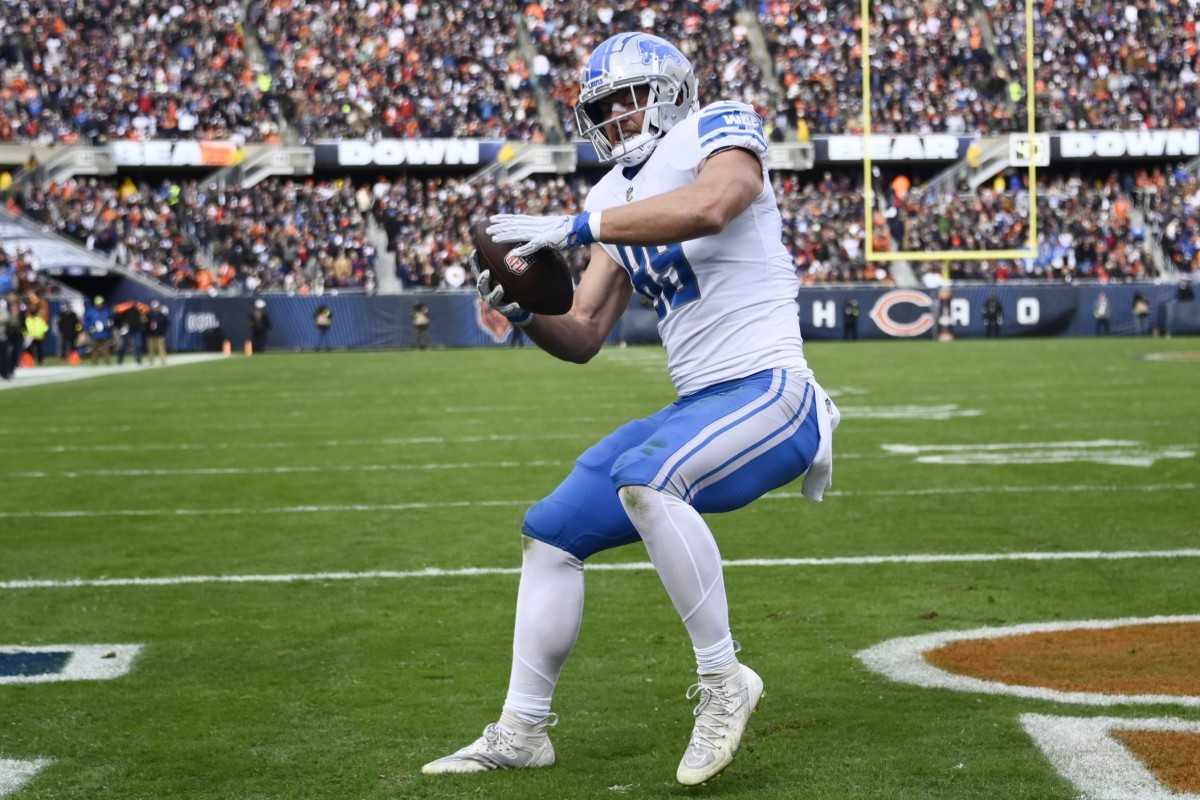
Tight Ends
At the start of the 2022 season, the Detroit Lions were looking to boast promise at the tight end position with All-Pro caliber player T.J. Hockenson. A former 2019 first-round pick by the team, the Iowa product entered his fourth season at Ford Field with 166 receptions, 1,673 receiving yards, and 12 touchdowns, with the middle number earning him a double-digit yards average in three of those campaigns. His season-high production in 2020 when he was held 723 yards and six touchdowns, respectively.
After seven starts with the franchise this fall, the Lions were heading towards a reset at 1-6 and elected to ship Hockenson off to their divisional rival Minnesota Vikings before the NFL trade deadline. While Detroit earned a second and third-round pick for 2023 and 2024 from the exchange, the No. 1 tight end’s departure also left a gaping hole for several depth players to fill.
The tight end candidate chosen by Detroit to assume the starting role has been Brock Wright. A 6-foot-5, 255-pound player out of Notre Dame, Wright joined the Lions as an undrafted free agent in May 2021 after posting a nearly silent receiving resume at the collegiate level. In three years with the Fighting Irish, he caught just seven receptions for 78 yards and one touchdown, seriously limiting his stock as a dynamic tight end in that April’s draft.
Since becoming a Lion, Wright’s numbers haven’t become groundbreaking to consider him a high-volume threat in the passing game. In 19 total appearances, he’s accumulated 19 receptions for 207 yards, three touchdowns, and an average of 10.9 yards per catch. His 2022 numbers stand at seven catches for 90 yards and one touchdown, the eighth-most among Lions’ receivers.
While those numbers are bound to improve with Wright picking up the production responsibilities of his position, expect him to be deployed as a front-line blocker in run protection schemes as well. The Lions will throw in Wright and a counterpart on both sides of the line for jumbo packages or use him alone on the edge as step-in blocker for the outside run game.
In the aerial attack, Wright could see some snaps in three-receiver sets either as the inside route runner or slot weapon. The Lions could send him on short routes over the top of the line for intermediate yardage and a first-down conversion or have him decoy as a blocker in the screen game. His production in the last three games has been close to nil, so the 23-year-old will have to earn the respect of the defense as a serious threat in the open field.
Following Wright, the Lions also have James Mitchell and Shane Zylstra on their tight end roster. The two have barely scraped the leaderboards with four receptions and 23 yards between them but have two of the Lions’ 15 touchdowns this season. Their snaps will likely be limited, but watch for an appearance next to the goal line for a catch or extra blockers.
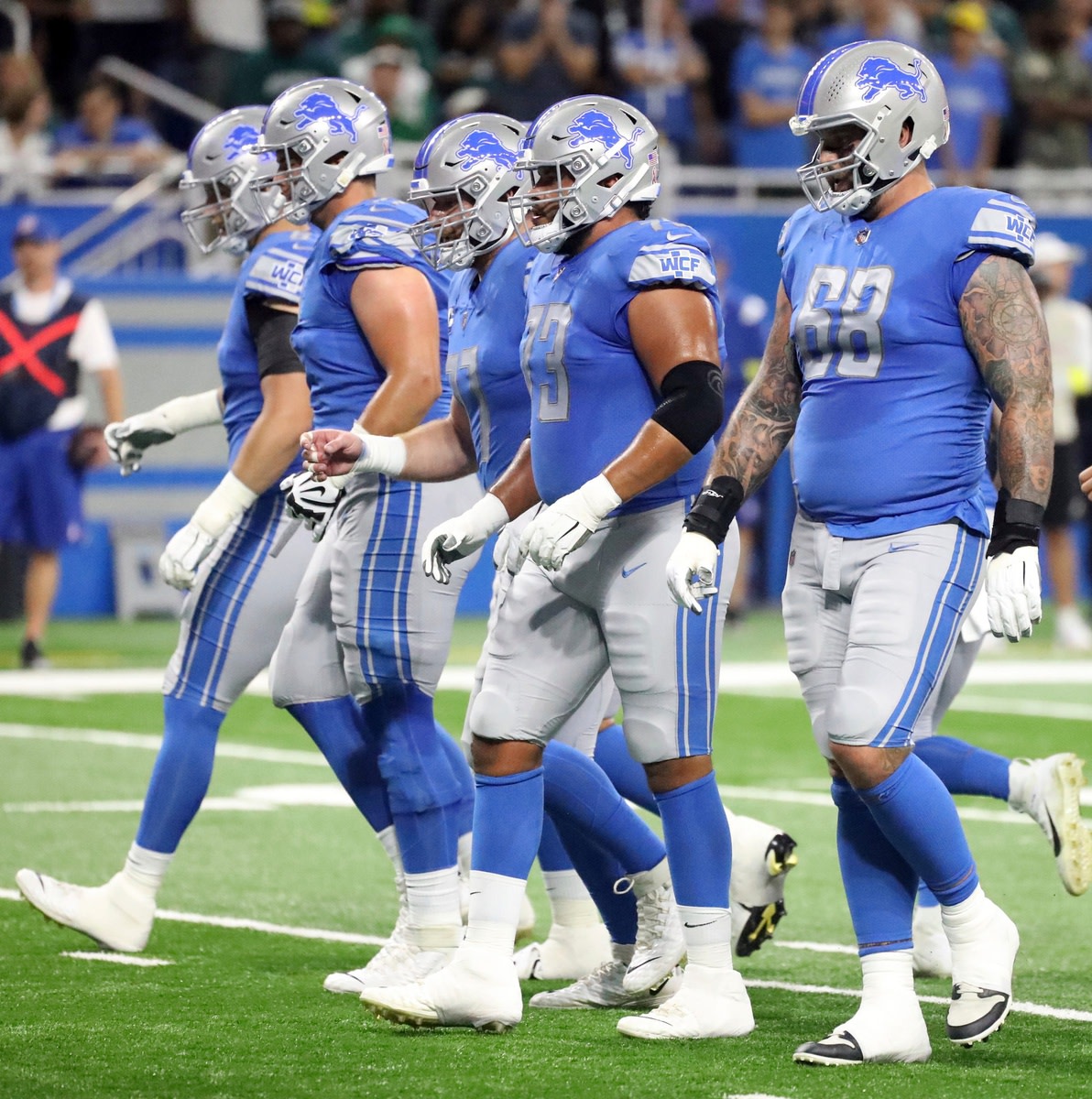
Offensive Line
For those seeking stability within the Detroit Lions’ offense, look no further than the rare commodity that is their offensive line behind offensive line coach Hank Fraley.
After holding one of the NFL’s best front lines in 2021, the Lions had no tough times deciding their starting unit in training camp. All five incumbents, including four players with at least three years of experience, returned healthy for the campaign. Detroit also brought back numerous reserves, allowing for immediate comfortability and connection within the team’s system.
If there is one concern to be had about the starting five, it’s that the group never played the entire 2021 season together due to injuries. Despite that, the unit is chocked full of talent with four Pro-Bowl contenders and posted impressive numbers out of the starts they managed to accumulate.
Most notably, the first five members helped the Lions plow for better than 1,800 yards on the ground with 12 rushing touchdowns and a 4.4-yard average, a feat the team hadn’t accomplished since 1998. Deploying the jumbo packages, they also allowed the 14th fewest sacks (36) and empowered the running backs to earn 1,641 of those rushing yards, the 11th-best marking in the NFL.
Rolling into MetLife to continue their first strong efforts, the starting offensive line for Detroit is as follows:
At left tackle, the Lions feature seventh-year pro Taylor Decker protecting Jared Goff’s blindside. The Ohio State product was a first-round draft pick by Detroit in 2016 and has grown to become one of the league’s top-10 offensive tackles at 6 '7”, 320 pounds.
While helping ensure Goff is protected long enough to utilize the play-action game to his strengths, the 28-year-old Decker has been one of the cleanest left tackles in limiting pressures from the edge. In nine games last season, he’s allowed three sacks and has only been penalized six times for holding infractions.
One interesting tidbit about Decker’s career in Detroit is his connection to the team’s unique receiving history. With a six-yard touchdown reception in the season finale last fall, he earned his second career scoring reception and became the only active offensive lineman in the NFC to hold multiple such a recognition.
Shifting to the left guard position, third-year Jonah Jackson returns to maintain the incumbent role. An Ohio State product like Decker, the 6’4”, 311-pound lineman was Detroit’s third-round pick in the 2020 draft and has appeared in 36 games since his selection.
Jackson earned a Pro Bowl designation in 2021 after playing 16 games and allowing only four sacks on his watch. He’s been one of the most consistent guards throughout his career and has been a key component in the success of Detroit’s run game.
Lining up in the middle is fifth-year center Frank Ragnow. The 6’5”, 309-pound lineman was the Lions’ first-round draft pick in 2018 and is coming off an injury that limited his 2021 season to just four games.
On Ragnow’s right shoulder, Halapoulivatti Vaitai started the year at right guard before receiving back surgery in September that cut his seventh campaign short. Since then, third-year pro Logan Stenberg has assumed the responsibility of protecting the right interior in his absence.
The Kentucky product appeared in seven games for the Lions last season and fought for one of the reserve spots on the team’s roster, beating out veteran Tommy Kraemer and two rookies during training camp. Yet, he has been a healthy scratch for most of his tenure in Detroit, and concerns linger with penalties and his hit-or-miss hand usage in pass protection.
Finally, second-year lineman Penei Sewell returns to the right tackle position. He was the Lions’ No. 7 overall pick in 2021 and has grown into a Pro-Bowler caliber talent on the right blindside. In 16 starts last fall, he allowed five sacks and eight penalties, but that figures to sharpen up with time in a consistent offensive system.
Join the Giants Country Community
- Sign up for our FREE digest newsletter
- Follow and like us on Facebook
- Submit your questions for our mailbag
- Check out the new Giants Country YouTube Channel.
- Listen and subscribe to the daily LockedOn Giants podcast.
- Subscribe and like the LockedOn Giants YouTube Channel
- Sign up for our FREE message board forums
- Get your Giants tickets today from SI Tickets!
-1ca98c375b90186224f7ec5e456f6e73.webp)